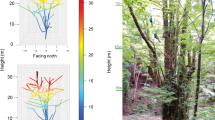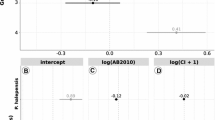Abstract
We examined the effects of different life history strategies and tree competition on species coexistence in a northern coniferous forest. We investigated the growth and demography of trees with stems ≥1 cm dbh in a 2-ha study plot in the Taisetsu Mountains of northern Japan. Three species, Abies sachalinensis, Picea jezoensis, and Picea glehnii, were found to be dominant in the forest. A. sachalinensis was the most dominant species in the understory, while the two Picea spp. were more abundant in the larger dbh size classes. The turnover rate of A. sachalinensis was about twice that of the Picea spp. The relative growth rate of understory trees in each species did not differ between different canopy conditions (closed canopy or canopy gap). The competitive advantage between A. sachalinensis and P. glehnii switched as they grew from understory (A. sachalinensis superior competitor) to canopy trees (P. glehnii superior competitor). Meanwhile, A. sachalinensis and P. jezoensis exhibited different environmental preferences. We propose that reversal in competitive superiority between different growth stages and trade-off between longevity and turnover are more important factors to promote their coexistence than regeneration niche differentiation related to canopy gaps in this sub-boreal coniferous forest.






Similar content being viewed by others
References
Aiba S, Kohyama T (1996) Tree species stratification in relation to allometry and demography in a warm-temperate rain forest. J Ecol 84:207–218
Antos JA, Guest HJ, Parish R (2005) The tree seedling bank in an ancient montane forest: stress tolerators in a productive habitat. J Ecol 93:536–543
Archibold OW (1995) Ecology of world vegetation. Chapman and Hall, London
Begon M, Harper JL, Townsend CR (1996) Ecology: individuals, populations and communities, 3rd edn. Blackwell Science, Oxford
Brokaw N, Busing RT (2000) Niche versus chance and tree diversity in forest gaps. Trends Ecol Evol 15:183–188
Busing RT, White PS (1997) Species diversity and small-scale disturbance in an old-growth temperate forest: a consideration of gap partitioning concepts. Oikos 78:562–568
Canham CD (1989) Different responses to gaps among shade-tolerant tree species. Ecology 70:548–550
Condit R, Hubbell SP, Foster RB (1995) Mortality rates of 205 neotropical tree and shrub species and the impact of a severe drought. Ecol Monogr 65:419–439
Denslow JS (1980) Gap partitioning among tropical rainforest trees. Biotropica 12:47–55
Diggle PJ (1983) Statistical analysis of spatial point patterns. Academic Press, London, UK
Dobson AJ (1990) An introduction to generalized linear models (Chapman and Hall statistics text series), 2nd edn. Chapman and Hall, London
Fortin MJ, Dale MRT (2005) Spatial analysis: a guide for ecologists. Cambridge University Press, Cambridge
Gravel D, Beaudet M, Messier C (2008) Partitioning the factors of spatial variation in regeneration density of shade-tolerant tree species. Ecology 89:2879–2888
Grubb PJ (1977) The maintenance of species-richness in plant communities: the importance of the regeneration niche. Biol Rev 52:107–145
Haase P (1995) Spatial pattern analysis in ecology based on Ripley’s K-function: Introduction and methods of edge correction. J Veg Sci 6:575–582
Haase P (2001) Can isotropy vs. anisotropy in the spatial association of plant species reveal physical vs. biotic facilitation? J Veg Sci 12:127–136
Hara T, Nishimura N, Yamamoto S (1995) Tree competition and species coexistence in a cool-temperate old-growth forest in southwestern Japan. J Veg Sci 6:565–574
Hiura T, Sano J, Konno Y (1996) Age structure and response to fine-scale disturbances of Abies sachalinensis, Picea jezoensis, Picea glehnii, and Betula ermanii growing under the influence of a dwarf bamboo understory in northern Japan. Can J For Res 26:289–297
Kohyama T (1992) Size-structured multi-species model of rain forest trees. Funct Ecol 6:206–212
Kohyama T (1993) Size-structured tree populations in gap-dynamics forest—the forest architecture hypothesis for the stable coexistence of species. J Ecol 81:131–143
Kubota Y, Hara T (1995) Tree competition and species coexistence in a sub-boreal forest, northern Japan. Ann Bot 76:503–512
Kubota Y, Konno Y, Hiura T (1994) Stand structure and growth patterns of understorey trees in a coniferous forest, Taisetsuzan National Park, northern Japan. Ecol Res 9:333–341
Miyadokoro T, Nishimura N, Hoshino D, Yamamoto S (2004) Dynamics of forest canopy and major tree populations over nine years in a subalpine old-growth coniferous forest, central Japan. Ecoscience 11:130–136
Mori AS, Komiyama A (2008) Differential survival among life stages contributes to co-dominance of Abies mariesii and Abies veitchii in a sub-alpine old-growth forest. J Veg Sci 19:239–244
Mori A, Takeda H (2004) Effects of undisturbed canopy structure on population structure and species coexistence in an old-growth subalpine forest in central Japan. For Ecol Manag 200:89–100
Mori A, Mizumachi E, Osono T, Doi Y (2004) Substrate-associated seedling recruitment and establishment of major conifer species in an old-growth subalpine forest in central Japan. For Ecol Manag 196:287–297
Mori AS, Mizumachi E, Komiyama A (2007) Roles of disturbance and demographic non-equilibrium in species coexistence, inferred from 25-year dynamics of a late-successional old-growth subalpine forest. Forest Ecol Manag 241:74–83
Nakashizuka T (2001) Species coexistence in temperate, mixed deciduous forests. Trends Ecol Evol 16:205–210
Narukawa Y, Iida S, Tanouchi H, Abe S, Yamamoto S (2003) State of fallen logs and the occurrence of conifer seedlings and saplings in boreal and subalpine old-growth forests in Japan. Ecol Res 18:267–277
Nishimura N, Hara T, Miura M, Manabe T, Yamamoto S (2003) Tree competition and species coexistence in a warm-temperate old-growth evergreen broad-leaved forest in Japan. Plant Ecol 164:235–248
Nishimura N, Hara T, Kawatani M, Hoshino D, Yamamoto S (2005) Promotion of species co-existence in old-growth coniferous forest through interplay of life-history strategy and tree competition. J Veg Sci 16:549–558
Obiri JAF, Lawes MJ (2004) Chance versus determinism in canopy gap regeneration in coastal scarp forest in South Africa. J Veg Sci 15:539–547
Ohwi J, Kitagawa M (1992) New flora of Japan. Shibundo, Tokyo
Okuda M, Sumida A, Ishii H, Vetrova VP, Hara T (2008) Establishment and growth pattern of Pinus pumila under a forest canopy in central Kamchatka. Ecol Res 23:831–840
Parent S, Simard MJ, Morin H, Messier C (2003) Establishment and dynamics of the balsam fir seedling bank in old forests of northeastern Quebec. Can J For Res 33:597–603
Parish R, Antos JA (2006) Slow growth, long-lived trees and minimal disturbance characterize the dynamics of an ancient, montane forest in coastal British Columbia. Can J For Res 36:2826–2838
Ripley BD (1976) The second-order analysis of stationary processes. J Appl Prob 13:255–266
Sakamoto Y, Ishiguro M, Kitagawa G (1986) Akaike information criterion statistics (Mathematics and its applications Japanese series). D. Reidel Publishing Company, Dordrecht, Netherland
Sheil D, May RM (1996) Mortality and recruitment rate evaluations in heterogeneous tropical forests. J Ecol 84:91–100
Shinozaki K, Yoda K, Hozumi K, Kira T (1964a) A quantitative analysis of plant form—the pipe model theory I. Basic analysis. Jpn J Ecol 14:97–105
Shinozaki K, Yoda K, Hozumi K, Kira T (1964b) A quantitative analysis of plant form—the pipe model theory II. Further evidence of the theory and its application in forest ecology. Jpn J Ecol 14:133–139
Silvertown J (2004) Plant coexistence and the niche. Trends Ecol Evol 19:605–611
Simard MJ, Bergeron Y, Sirois L (1998) Conifer seedling recruitment in a southeastern Canadian boreal forest: the importance of substrate. J Veg Sci 9:575–582
Suzuki E, Ota K, Igarashi T, Fujiwara K (1987) Regeneration process of coniferous forests in northern Hokkaido. I. Abies sachalinensis forest and Picea glehnii forest. Ecol Res 2:61–75
Takahashi K (1997) Regeneration and coexistence of two subalpine conifer species in relation to dwarf bamboo in the understory. J Veg Sci 8:529–536
Taylor AH, Qin Z, Liu J (1996) Structure and dynamics of subalpine forests in the Wang Lang Natural Reserve, Sichuan, China. Vegetatio 124:25–38
Taylor AH, Jang SW, Zhao LJ, Liang CP, Miao CJ, Huang J (2006) Regeneration patterns and tree species coexistence in old-growth Abies–Picea forests in southwestern China. For Ecol Manag 223:303–317
Veblen TT (1986) Treefalls and the coexistence of conifers in subalpine forests of the central Rockies. Ecology 67:644–649
Veblen TT, Hadley KS, Reid MS (1991) Disturbance and stand development of a Colorado subalpine forest. J Biogeogr 18:707–716
Yamamoto S (1995) Gap characteristics and gap regeneration in subalpine old-growth coniferous forests, central Japan. Ecol Res 10:31–39
Acknowledgments
We thank the Kamikawa District Forest Office for allowing us to survey within the Taisetsu Mountains, and S. Abe, N. Ando, Y. Narukawa, H. Utsugi, and members of Laboratory of Forest Ecology and Physiology of Nagoya University and Biosphere Dynamics Research Group of Institute of Low Temperature Science of Hokkaido University for their assistance with data collection. This study was partly supported by Grants-in-Aid for Scientific Research (13356003, 14206017, 17580131, and 21570027) from the Japan Society for the Promotion of Science, and by the Grant for Joint Research Program of the Institute of Low Temperature Science, Hokkaido University.
Author information
Authors and Affiliations
Corresponding author
Additional information
Nomenclature: Ohwi and Kitagawa (1992).
Rights and permissions
About this article
Cite this article
Nishimura, N., Kato, K., Sumida, A. et al. Effects of life history strategies and tree competition on species coexistence in a sub-boreal coniferous forest of Japan. Plant Ecol 206, 29–40 (2010). https://doi.org/10.1007/s11258-009-9622-3
Received:
Accepted:
Published:
Issue Date:
DOI: https://doi.org/10.1007/s11258-009-9622-3




